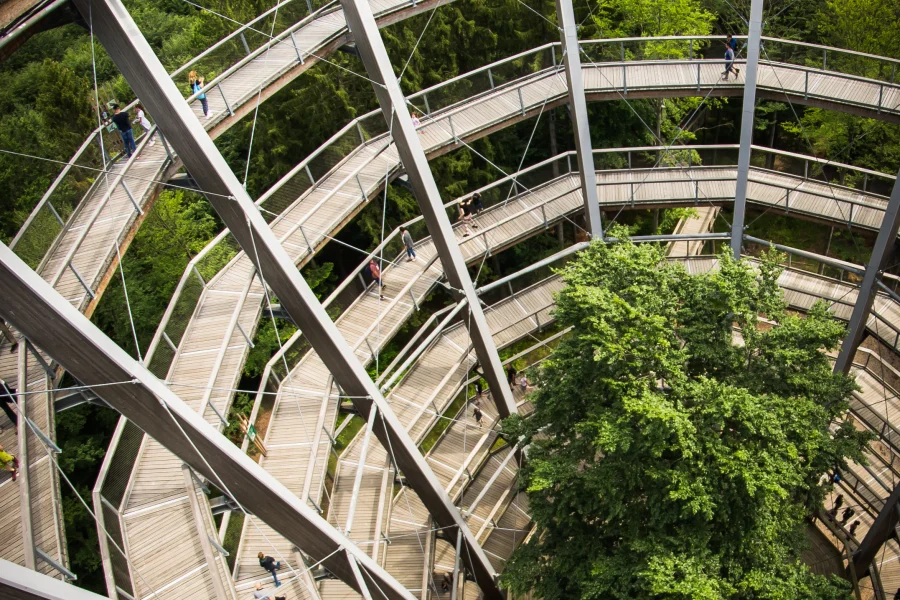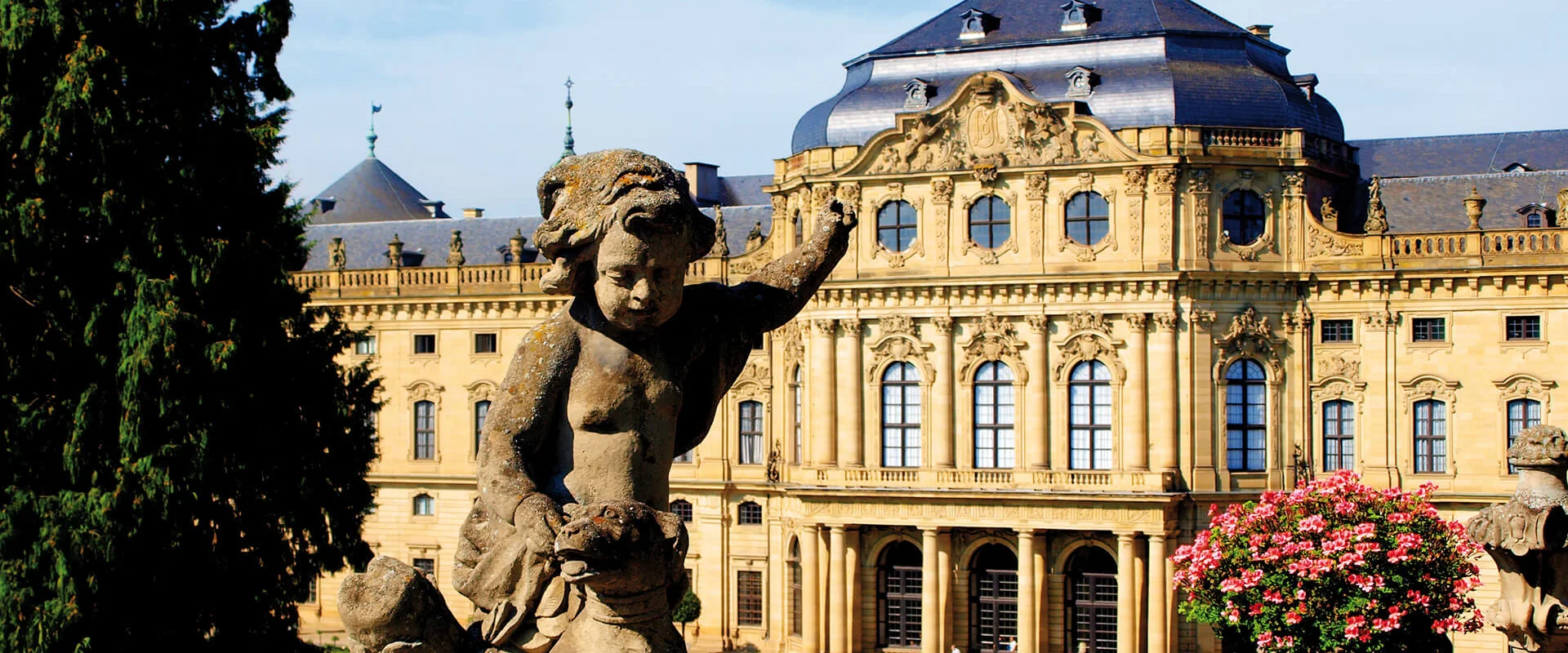Attractions in the region
"Franconia is like a magic cabinet; new drawers keep opening up to reveal a never-ending array of colourful, shiny treasures",
wrote the poet Karl Leberecht Immermann more than 160 years ago
You will get to know many of the drawers of the magic cabinet during your holiday at the "Benediktiner"! Here you can forget everyday life, relax and unwind, take in the culture or experience active recreation.
In the region:
Discover the fortified towns of Main-Franconia – hidden between walls and towers with a view of the vineyards are little gems such as Sommerhausen, Mainbernheim, Iphofen or Sulzfeld. The small havens with their vine arbours and half-timbered houses are the epitome of romantic Franconia and offer cosy conviviality, best enjoyed over a glass of wine.
In close proximity:
The Steigerwald treetop trail is a real insider's tip.
A 1,150-metre-long wooden walkway winds through all levels of the forest, culminating in a 42-metre-high, goblet-shaped lookout tower. A circular walkway along the outside of the tower leads up to the top level, offering stunning panoramic views of the densely wooded Steigerwald landscape.
At our hotel:
A good glass of wine from Franconian "Bocksbeutelland” is best enjoyed by wine lovers and art connoisseurs in the Benediktiner's Balthasar-Neumann Room. Here you can enjoy culinary delights and rare vintages under the unique and highly prized original oil painting of Balthasar Neumann's basilica, which was built towards the end of the 18th century.

Attractions in and around Münsterschwarzach
The Benedictine monastery in Münsterschwarzach already existed in the days of Charlemagne. The baroque church, built by Balthasar Neumann in 1727-1734, was demolished following secularisation in 1821-1827. The Benedictines were only allowed to return in 1913. They commissioned A. Boßlet to build the present-day cathedral, which took its inspiration from the shape of Speyer Cathedral.
Today, about 100 Benedictine monks still live in Münsterschwarzach Monastery, many of whom are still actively involved in the mission. A special attraction is therefore the Mission Museum in the monastery, which is open Mondays – Saturdays from 8h30 – 12h00 and 13h00 – 17h00 and on Sundays from 10h30 – 12h00 and in the afternoons. The information centre directly in the gatehouse is particularly recommendable.
On the way to Volkach, the route first leads to Sommerach, famous for its asparagus and wine. In front of the gate, you can admire the “graue Marter”, a late Gothic wayside shrine. Further along the road to Volkach, a path turns off to the left to Hallburg Castle, surrounded by vineyards. Today it is owned by the Counts of Schönborn. Hallburg Castle offers beautiful views of the town of Volkach.
Worthy of special mention here are the Schelfenhaus, the typically Franconian town hall, and the 19th-century town parish church.
Münsterschwarzach Benedictine Monastery.
Wiesentheid Castle Garden
“Maria im Weingarten" pilgrimage church
South of Volkach you will reach the foot of the Kirchberg. Stations of the Way of the Cross through the vineyard take you up to the pilgrimage church "Maria im Weingarten", where you can see the famous “Madonna of the Rosary” by Tilman Riemenschneider.
At Volkach, crossing the Main at Astheim in the direction of Würzburg, you reach Vogelsburg Castle. From there, you can enjoy a magnificent view over the entire river Main loop. Don't miss out on a visit to the winegrowing village of Escherndorf at the foot of Vogelsburg Castle, whose famous Lump and Fürstenberg vineyards have a reputation that extends far beyond Franconia.
Leaving the river Main loop behind, we now head towards Steigerwald forest. Wiesentheid, also called the gateway to the Steigerwald, is the seat of the Counts of Schönborn, whose moated castle with castle garden is located directly opposite the St. Mauritius parish church, which was built to the design of Balthasar Neumann.
Only 3 km away from Wiesentheid lies Prichsenstadt, which with its medieval centre, the town wall and the many turrets is somewhat reminiscent of Rothenburg ob der Tauber.
In Rüdenhausen, the influence of the Princes of Castell, who own two smaller castles here, is already unmistakable.
Castell
Schwanberg
Schwanberg
A few kilometres away lies Castell, hugging the slopes of the Schlossberg. This is also where the ruins of the upper castle are situated. The new castle in the village, built between 1687 and 1691, is the principal residence of the Princes of Castell. Count Friedrich Ludwig (1865), an enthusiastic botanist, added an English park in front of the west side. A lively wine festival is held there every year, hosted by the Prince of Castell.
The Protestant regional church is also noteworthy. On the way to Iphofen, a path branches off past Wiesenbronn onto the Schwanberg, the landmark of the southern Steigerwald. The castle of the Princes of Castell above the vineyards is now the seat of a Protestant training centre.
Schwanberg
To the east, the view stretches across countryside and meadows. From Schwanberg, it is of course possible to explore the Steigerwald Nature Park on foot. After passing Schwanberg and via Rödelsee, you reach Iphofen with its late medieval fortifications. Notable attractions include Rödelseer Tor, the town hall on the market square and the parish church of St. Vait with its two statues of St. John by Tilman Riemenschneider. A visit to the Knauf Museum is also not to be missed.
Passing the Mainbernheim Walls, you then reach Kitzingen. In front of the old Main bridge on the right is the Chapel of the Holy Cross designed by B. Neumann 1741 – 1745. An unusual feature here is the chancel terminus, which is set off by three arcades whose columns appear to the visitor to belonging to the dome girders. Looking west on the bridge ramp, you can see the Falterturm with its crooked, leaning roof (now the carnival museum). Other towers include the Gothic spire of the Catholic parish church of St. John the Baptist, the town hall (three-storey block with gables and tower) and the Protestant parish church. Its sacristy exhibits the Bible of the Wittenberg professor Paul Eber, a friend of Martin Luther.
The route back to Schwarzach via Mainstockheim takes you to Dettelbach. Worthy of mention here are the portal of the pilgrimage church and the town hall built in typical Franconian style.

